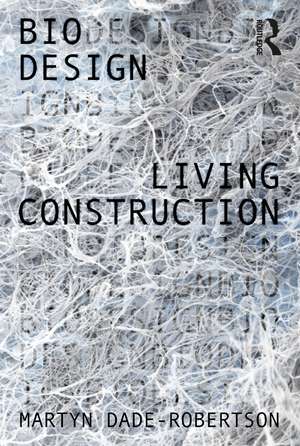Living Construction: Bio Design
Autor Martyn Dade-Robertsonen Limba Engleză Hardback – 29 oct 2020
This book, the first in the Bio Design series, acts as a bridge between design speculation and scientific reality and between contemporary design thinking, in areas such as architecture, product design and fashion design, and the traditional engineering approaches which currently dominate biotechnologies. Filled with real examples, Living Construction reveals how living cells construct and transform materials through methods of fabrication and assembly at multiple scales and how designers can utilize these processes.
| Toate formatele și edițiile | Preț | Express |
|---|---|---|
| Paperback (1) | 212.85 lei 22-36 zile | +6.93 lei 6-12 zile |
| Taylor & Francis – 29 oct 2020 | 212.85 lei 22-36 zile | +6.93 lei 6-12 zile |
| Hardback (1) | 763.07 lei 43-57 zile | |
| Taylor & Francis – 29 oct 2020 | 763.07 lei 43-57 zile |
Preț: 763.07 lei
Preț vechi: 1026.76 lei
-26% Nou
Puncte Express: 1145
Preț estimativ în valută:
146.03€ • 151.90$ • 120.56£
146.03€ • 151.90$ • 120.56£
Carte tipărită la comandă
Livrare economică 14-28 aprilie
Preluare comenzi: 021 569.72.76
Specificații
ISBN-13: 9781138363014
ISBN-10: 1138363014
Pagini: 122
Ilustrații: 26 Line drawings, black and white; 6 Halftones, black and white; 32 Illustrations, black and white
Dimensiuni: 129 x 198 mm
Greutate: 0.39 kg
Ediția:1
Editura: Taylor & Francis
Colecția Routledge
Seria Bio Design
Locul publicării:Oxford, United Kingdom
ISBN-10: 1138363014
Pagini: 122
Ilustrații: 26 Line drawings, black and white; 6 Halftones, black and white; 32 Illustrations, black and white
Dimensiuni: 129 x 198 mm
Greutate: 0.39 kg
Ediția:1
Editura: Taylor & Francis
Colecția Routledge
Seria Bio Design
Locul publicării:Oxford, United Kingdom
Public țintă
Postgraduate, Professional, Professional Practice & Development, and UndergraduateCuprins
1. Introduction 2. The designs of the natural 3. The logic of living assembly 4. Fabrication in the living 5. Conclusion: the craft of living construction
Notă biografică
Martyn Dade-Robertson is Professor of Emerging Technology at the School of Architecture, Planning and Landscape at Newcastle University and the Co-Director of the Hub for Biotechnology in the Built Environment. He holds degrees in architecture, architectural computing and synthetic biology.
Recenzii
"This inspiring and informative book asks how we might construct material structures using biology. Its author, an architect and qualified synthetic biologist, is uniquely able to combine ambitious design and down-to-bench realism. Constructed around ideas – of life, of design, of fabrication – the book provides an ideal springboard to a biological architecture grounded, not in conceptual fantasies, but on what might really be achieved."Jamie A. Davies, Professor of Experimental Anatomy, University of Edinburgh
"Living Construction is a readable synthesis of important principles for the new field of biodesign, written by someone with graduate training in both architecture and synthetic biology. Dade-Robertson clearly knows the details but has the gift of extrapolating these into accurate yet broad generalities. While design and biology each has its disciplinary theories and practices, this book distills sound principles for their intersection in biodesign, offering a very useful contemporary map for practitioners in the arts and sciences. I especially admire his answer to his own question, 'where is the information in biological assembly?', for how it addresses multiple scales simultaneously. This is a key primer for all students in biodesign."
Christina Cogdell, Professor, University of California at Davis
"Living Construction is a readable synthesis of important principles for the new field of biodesign, written by someone with graduate training in both architecture and synthetic biology. Dade-Robertson clearly knows the details but has the gift of extrapolating these into accurate yet broad generalities. While design and biology each has its disciplinary theories and practices, this book distills sound principles for their intersection in biodesign, offering a very useful contemporary map for practitioners in the arts and sciences. I especially admire his answer to his own question, 'where is the information in biological assembly?', for how it addresses multiple scales simultaneously. This is a key primer for all students in biodesign."
Christina Cogdell, Professor, University of California at Davis
Descriere
This book, the first in the Bio Design series, acts as a bridge between design speculation and scientific reality, and between contemporary design thinking, in areas such as architecture, product design and fashion design, and the traditional engineering approaches which currently dominate bio technologies.



